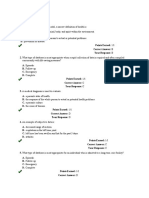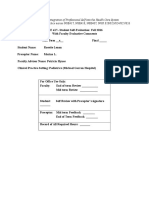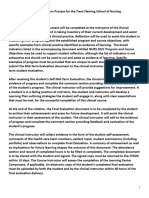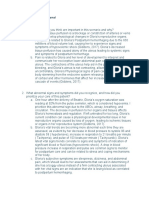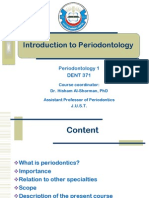50%(4)50% found this document useful (4 votes)
1K viewsJarvis Chapter 15
Jarvis Chapter 15
Uploaded by
lily flowerhealth assessmet
Copyright:
© All Rights Reserved
Available Formats
Download as DOCX, PDF, TXT or read online from Scribd
Jarvis Chapter 15
Jarvis Chapter 15
Uploaded by
lily flower50%(4)50% found this document useful (4 votes)
1K views4 pageshealth assessmet
Copyright
© © All Rights Reserved
Available Formats
DOCX, PDF, TXT or read online from Scribd
Share this document
Did you find this document useful?
Is this content inappropriate?
health assessmet
Copyright:
© All Rights Reserved
Available Formats
Download as DOCX, PDF, TXT or read online from Scribd
Download as docx, pdf, or txt
50%(4)50% found this document useful (4 votes)
1K views4 pagesJarvis Chapter 15
Jarvis Chapter 15
Uploaded by
lily flowerhealth assessmet
Copyright:
© All Rights Reserved
Available Formats
Download as DOCX, PDF, TXT or read online from Scribd
Download as docx, pdf, or txt
You are on page 1of 4
Key Points Print
Jarvis: Physical Examination & Health Assessment, 6th Edition
Chapter 15: Ears
Key Points Print
This section discusses key points about the structure and function of the
ears.
The ear is the sensory organ for hearing and maintaining equilibrium.
It has three parts: the external, middle, and inner ear.
The external ear (or auricle or pinna) has six landmarks: the helix,
antihelix, external auditory meatus, tragus, antitragus, and lobule.
The translucent, pearly gray, tympanic membrane (or eardrum)
separates the external and middle ear. Otoscopic inspection of this
membrane reveals several features:
o A prominent cone of light is visible.
o The malleus pulls at the center of the ear, causing it to appear oval
and slightly concave.
o Almost in the center, the umbo is where the first ossicle is
attached.
o The pars flaccida is the small, slack, superior section of the
membrane.
o The pars tensa is the remainder of the membrane. It is thicker and
more taut.
The middle ear is a small air-filled cavity inside the temporal bone. It
contains tiny ear bones: the malleus, incus, and stapes. The middle ear
has three functions:
o It conducts sound vibrations from the outer ear to the central
hearing apparatus in the inner ear.
o It protects the inner ear by reducing the amplitude of loud
sounds.
Elsevier items and derived items 2012, 2008, 2004, 2000, 1996, 1992 by Saunders, an imprint of
Elsevier Inc.
Key Points Print
o And its eustachian tube allows equalization of air pressure on
each side of the tympanic membrane.
The inner ear contains the bony labyrinth, which holds the sensory
organs for equilibrium and hearing. In the labyrinth, the vestibule and
semicircular canals compose the vestibular apparatus, and the cochlea
contains the central hearing apparatus. Although the inner ear is not
accessible to direct examination, you can assess its function.
Hearing involves the auditory system at the peripheral level,
brainstem, and cerebral cortex. The ear transmits sound and converts
its vibrations into electrical impulses, which the brain analyzes. Anything
that obstructs sound transmission impairs hearing. Hearing loss may
be conductive, sensorineural, or mixed.
o Conductive hearing loss involves a mechanical dysfunction of the
external or middle ear. If the sound amplitude is increased enough,
the person can hear. Cerumen buildup and otosclerosis may cause
conductive hearing loss.
o Sensorineural or perceptive hearing loss indicates a pathologic
condition of cranial nerve eight. Presbycusis, an age-related
gradual degeneration of the nerve, may be the cause.
o Mixed hearing loss results from conductive and sensorineural
causes.
At different developmental stages, anatomic differences alter hearing.
o In infants, the eustachian tube is relatively short and wide and is
more horizontal than it is in an adult. This allows pathogens to
migrate to the middle ear from the nasopharynx. Also, the lumen is
easily occluded.
o In adults younger than age 40, otosclerosis is a common cause of
conductive hearing loss.
Elsevier items and derived items 2012, 2008, 2004, 2000, 1996, 1992 by Saunders, an imprint of
Elsevier Inc.
Key Points Print
o In aging adults, hearing acuity may be decreased because of the
coarse and stiff cilia lining the ear, impacted cerumen, and nerve
degeneration in the inner ear.
This section presents critical points about subjective and objective
assessments of the ears.
To obtain subjective data, ask questions that investigate
these topics:
o Earaches,
o Ear infections,
o Discharge from the ears,
o Hearing loss,
o Environmental noise,
o Tinnitus,
o Vertigo,
o And self-care behaviors.
To obtain objective data, first inspect and palpate the external ear.
o Note the size and shape of the auricle and the ear position and
alignment on the head. Observe the skin condition, including
color and any lumps or lesions.
o Check for movement of the auricle, and palpate the pinna, tragus,
and mastoid process to detect tenderness.
o Evaluate the external auditory meatus, noting its size and any
swelling, redness, discharge, cerumen, lesions, or foreign bodies.
Next perform an otoscopic examination.
o Inspect the external canal, again looking for any cerumen,
discharge, foreign bodies, or lesions. Also check the canal wall for
redness or swelling.
Elsevier items and derived items 2012, 2008, 2004, 2000, 1996, 1992 by Saunders, an imprint of
Elsevier Inc.
Key Points Print
o With the otoscope, inspect the tympanic membrane. Observe its
color and characteristics. Note its position, which may be flat,
bulging, or retracted. Also assess the integrity of the membrane.
Then test hearing acuity. First, note the patients behavioral response to
conversational speech.
o If indicated, perform the whispered voice test. If needed, perform
tuning fork tests to measure hearing by air conduction or by bone
conduction.
To assess the vestibular apparatus, perform the Romberg test, which
evaluates standing balance.
Based on the patients developmental stage, adjust your assessment
technique or expected findings. For example, for a child, use different
tests to assess hearing acuity. In an older adult, expect the tympanic
membrane to appear whiter, more opaque, and duller than in a
younger adult.
During the ear assessment, incorporate health promotion. For instance,
teach young people about the risk of hearing loss with digital music
players and earbuds, and suggest ways to prevent hearing loss from the
overuse of these devices.
Elsevier items and derived items 2012, 2008, 2004, 2000, 1996, 1992 by Saunders, an imprint of
Elsevier Inc.
You might also like
- Health Assessment For Nursing Practice 6th EditionDocument11 pagesHealth Assessment For Nursing Practice 6th Editiontanedip.focicen100% (1)
- NURS1002-Berman Audrey-Skills in Clinical Nursing-Section 12 Hand Hygiene-Pp6-11Document87 pagesNURS1002-Berman Audrey-Skills in Clinical Nursing-Section 12 Hand Hygiene-Pp6-11dannyrorke9530No ratings yet
- Nursing Home Lesson PlanDocument3 pagesNursing Home Lesson Planapi-353697276100% (2)
- TB-Chapter 28 The Complete Health Assessment Adult PDFDocument13 pagesTB-Chapter 28 The Complete Health Assessment Adult PDFShawya Assadi100% (1)
- Purdue University Global Grade Report 1Document4 pagesPurdue University Global Grade Report 1api-529055115No ratings yet
- DocDocument1 pageDocfelamendo0% (1)
- Ambulance Service SOPDocument23 pagesAmbulance Service SOPAnonymous wJTlxhI100% (3)
- Care of The Patient With COVID-19 COVID Case Study 1Document3 pagesCare of The Patient With COVID-19 COVID Case Study 1Ashley HernandezNo ratings yet
- TB-Chapter 16 Ears PDFDocument17 pagesTB-Chapter 16 Ears PDFShawya Assadi100% (2)
- TB-Chapter 24 Neurologic System PDFDocument24 pagesTB-Chapter 24 Neurologic System PDFShawya Assadi100% (3)
- TB-Chapter 29 The Complete Physical Assessment Infant, Child, and Adolescent PDFDocument3 pagesTB-Chapter 29 The Complete Physical Assessment Infant, Child, and Adolescent PDFShawya AssadiNo ratings yet
- TB-Chapter 13 Skin, Hair, and Nails PDFDocument21 pagesTB-Chapter 13 Skin, Hair, and Nails PDFShawya Assadi100% (3)
- Windshield Survey: Elements & Descriptions Community ObservationsDocument6 pagesWindshield Survey: Elements & Descriptions Community Observationslesliecurtis79100% (1)
- Jarvis Chapter 18 Study GuideDocument5 pagesJarvis Chapter 18 Study GuideEmily Cheng100% (2)
- Midterm Fall 2017 CeccDocument13 pagesMidterm Fall 2017 Ceccapi-271855323No ratings yet
- Chapter 5Document3 pagesChapter 5aznknight323No ratings yet
- Health AssessmentttDocument64 pagesHealth AssessmentttAudreySalvador100% (4)
- Ch14 Jarvis Test BankDocument13 pagesCh14 Jarvis Test BankRaghavanJayaraman100% (12)
- Head To Toe Assessment in 5 Minutes or MoreDocument12 pagesHead To Toe Assessment in 5 Minutes or MoreTSPANNo ratings yet
- Jarvis Physical Examination Health Assessment Chap - 01Document18 pagesJarvis Physical Examination Health Assessment Chap - 01Don Rivetts94% (18)
- JARVIS Health Assessment Quiz #3 NURS 372091 372090Document5 pagesJARVIS Health Assessment Quiz #3 NURS 372091 372090CTuagNo ratings yet
- PICOTDocument1 pagePICOTmelodia gandezaNo ratings yet
- TB-Chapter 27 Female Genitourinary System PDFDocument22 pagesTB-Chapter 27 Female Genitourinary System PDFShawya Assadi100% (1)
- Health Assessment JarvisDocument14 pagesHealth Assessment JarvisLilly Daye81% (31)
- 2015 7th Jarvis Physical Examination and Health Assessment Chapter 14Document13 pages2015 7th Jarvis Physical Examination and Health Assessment Chapter 14addNo ratings yet
- 1 3 4 5 8 11 JarvisDocument12 pages1 3 4 5 8 11 Jarvispeachysurro100% (5)
- Examination of The AbdomenDocument4 pagesExamination of The Abdomenjamie_rubinNo ratings yet
- TB-Chapter 09 General Survey and Measurement PDFDocument7 pagesTB-Chapter 09 General Survey and Measurement PDFShawya Assadi100% (1)
- Chapter 05: The Complete Health History Jarvis: Physical Examination & Health Assessment, 3rd Canadian EditionDocument11 pagesChapter 05: The Complete Health History Jarvis: Physical Examination & Health Assessment, 3rd Canadian EditiongeorgelaNo ratings yet
- Chapter 08: Interpersonal Violence Assessments Jarvis: Physical Examination & Health Assessment, 3rd Canadian EditionDocument7 pagesChapter 08: Interpersonal Violence Assessments Jarvis: Physical Examination & Health Assessment, 3rd Canadian EditiongeorgelaNo ratings yet
- Self Assessment - Midterm 2016Document11 pagesSelf Assessment - Midterm 2016api-341527743No ratings yet
- TB-Chapter 06 Substance Use Assessment PDFDocument6 pagesTB-Chapter 06 Substance Use Assessment PDFShawya AssadiNo ratings yet
- TB-Chapter 12 Nutrition Assessment PDFDocument14 pagesTB-Chapter 12 Nutrition Assessment PDFShawya Assadi100% (1)
- Chapter 11: Pain Assessment Jarvis: Physical Examination & Health Assessment, 3rd Canadian EditionDocument6 pagesChapter 11: Pain Assessment Jarvis: Physical Examination & Health Assessment, 3rd Canadian EditiongeorgelaNo ratings yet
- Test Bank For Brunner and Suddarths Textbook of Medical Surgical Nursing 11th Edition Suzanne C SmeltzerDocument8 pagesTest Bank For Brunner and Suddarths Textbook of Medical Surgical Nursing 11th Edition Suzanne C SmeltzerphelanaurelianrjuNo ratings yet
- Chapter 07: Substance Use and Health Assessment Jarvis: Physical Examination & Health Assessment, 3rd Canadian EditionDocument7 pagesChapter 07: Substance Use and Health Assessment Jarvis: Physical Examination & Health Assessment, 3rd Canadian EditiongeorgelaNo ratings yet
- Objectives May Be Used To Support Student Reflection, Although The List of Indicators Is NotDocument14 pagesObjectives May Be Used To Support Student Reflection, Although The List of Indicators Is Notapi-456466614No ratings yet
- Chapter 6Document3 pagesChapter 6aznknight323No ratings yet
- Overview Nursing ResearchDocument9 pagesOverview Nursing ResearchWadyanNo ratings yet
- TB-Chapter 19 Thorax and Lungs PDFDocument18 pagesTB-Chapter 19 Thorax and Lungs PDFShawya Assadi100% (5)
- Final EvaluationDocument17 pagesFinal Evaluationapi-603938769No ratings yet
- Thorax and Lungs Jarvis-Chap 18Document94 pagesThorax and Lungs Jarvis-Chap 18guy3280100% (6)
- Physical Examination and Health AssessmentDocument6 pagesPhysical Examination and Health AssessmentJulie PalmerNo ratings yet
- TB-Chapter 17 Nose, Mouth, and Throat PDFDocument18 pagesTB-Chapter 17 Nose, Mouth, and Throat PDFShawya Assadi100% (3)
- Behavioral Health Care PlanDocument12 pagesBehavioral Health Care Planapi-520841770100% (1)
- Potter: Fundamentals of Nursing, 9th Edition: Chapter 45: NutritionDocument3 pagesPotter: Fundamentals of Nursing, 9th Edition: Chapter 45: NutritionStacey100% (1)
- Chapter 0017 MedDocument9 pagesChapter 0017 Medquizme908100% (1)
- Nursing AssessmentDocument16 pagesNursing AssessmentJihan Novita100% (1)
- Jarvis Physical Assessment Chapter 14Document19 pagesJarvis Physical Assessment Chapter 14Giorgia Adams100% (2)
- Proofed - Nurs 3021 Final EvaulDocument20 pagesProofed - Nurs 3021 Final Evaulapi-313199824No ratings yet
- Brendan Morano Final EvaluationDocument15 pagesBrendan Morano Final Evaluationapi-546391110No ratings yet
- Chapter 030Document16 pagesChapter 030dtheart2821100% (3)
- Musculoskeletal System Musculoskeletal System: A. SkeletonDocument23 pagesMusculoskeletal System Musculoskeletal System: A. SkeletonTina TalmadgeNo ratings yet
- Nursing Care PlanDocument6 pagesNursing Care PlanChesca MejiaNo ratings yet
- FinalotmhDocument13 pagesFinalotmhapi-315469477100% (1)
- FundamentalsDocument30 pagesFundamentalsRachel PerandoNo ratings yet
- Health Assessment: Nursing ProcessDocument7 pagesHealth Assessment: Nursing ProcessAngelrica TumbadoNo ratings yet
- Refelctive Journal Development 346Document2 pagesRefelctive Journal Development 346Jennifer Goodlet100% (1)
- Women S Health FinalDocument31 pagesWomen S Health Finalerick kanyi100% (1)
- Nursing care process in patients with chronic obstructive pulmonary diseaseFrom EverandNursing care process in patients with chronic obstructive pulmonary diseaseNo ratings yet
- M. Flory - COM 090 MWF - Syllabus - Spring 2017Document9 pagesM. Flory - COM 090 MWF - Syllabus - Spring 2017lily flowerNo ratings yet
- OB Final Study GuideDocument21 pagesOB Final Study Guidelily flowerNo ratings yet
- Methods of ContraceptionDocument9 pagesMethods of Contraceptionlily flower100% (1)
- Lorem Ipsum Dolor: Activity Recommendatio NDocument2 pagesLorem Ipsum Dolor: Activity Recommendatio Nlily flowerNo ratings yet
- Peds ArticleDocument27 pagesPeds Articlelily flowerNo ratings yet
- Atorvastatin Why The Patient Is On It: DosageDocument6 pagesAtorvastatin Why The Patient Is On It: Dosagelily flowerNo ratings yet
- Scavanger Injection RatesDocument6 pagesScavanger Injection RatesAnonymous QSfDsVxjZNo ratings yet
- SNSD - Run Devil RunDocument16 pagesSNSD - Run Devil RunAisy SarahNo ratings yet
- KolkataDocument27 pagesKolkataAbhishek RayNo ratings yet
- Curriculum Objectives Strand Unit: Sending, Receiving and TravellingDocument5 pagesCurriculum Objectives Strand Unit: Sending, Receiving and TravellingmatkaiNo ratings yet
- Ecpmi Ecpmms: 2019: Ethiopian Construction Project Management Manuals SeriesDocument73 pagesEcpmi Ecpmms: 2019: Ethiopian Construction Project Management Manuals SeriesKalkidanNo ratings yet
- 20140804Document28 pages20140804កំពូលបុរសឯកាNo ratings yet
- nRISK ASSESSMENT REPORT - Construction of Spud Pillars On A BargeDocument3 pagesnRISK ASSESSMENT REPORT - Construction of Spud Pillars On A BargeTerryNo ratings yet
- The Power of Positive ThinkingDocument31 pagesThe Power of Positive ThinkingGD gamingdewe100% (1)
- Tissue Salt Primer SchuesslerDocument36 pagesTissue Salt Primer SchuesslerYanka IlarionovaNo ratings yet
- Personnel Planning and Recruiting: Gary DesslerDocument48 pagesPersonnel Planning and Recruiting: Gary DesslerAnamul Haque SazzadNo ratings yet
- Jyothy Labs Q1FY21: Financial Results & HighlightsDocument3 pagesJyothy Labs Q1FY21: Financial Results & HighlightsSam vermNo ratings yet
- Impact of Coronavirus On Livelihoods of RMG Workers in Urban DhakaDocument11 pagesImpact of Coronavirus On Livelihoods of RMG Workers in Urban Dhakaanon_4822610110% (1)
- CS Clean SolutionsDocument15 pagesCS Clean SolutionsCS CleanNo ratings yet
- Confirmation - Check-InDocument2 pagesConfirmation - Check-InTaqien AbscNo ratings yet
- Mark The Letter A, B, C, or D On Your Answer Sheet To Indicate The Correct Answer To Each of The Following QuestionsDocument18 pagesMark The Letter A, B, C, or D On Your Answer Sheet To Indicate The Correct Answer To Each of The Following QuestionsĐỗ Hoàng DũngNo ratings yet
- Physical EducationDocument3 pagesPhysical EducationCHARIZE MAE NAVARRONo ratings yet
- Codes & Standards For Natural GasDocument13 pagesCodes & Standards For Natural Gasharikrishnanpd3327No ratings yet
- Crane Accidents From Nis - Mobile Cranes & Boom TrucksDocument14 pagesCrane Accidents From Nis - Mobile Cranes & Boom TrucksLuis De La HozNo ratings yet
- Hyundai Welding Co., LTD.: Low Alloy, Cellulosic Smaw For PipeDocument6 pagesHyundai Welding Co., LTD.: Low Alloy, Cellulosic Smaw For PipeKali AbdennourNo ratings yet
- 100 and 900 Wing-T PDocument163 pages100 and 900 Wing-T PMichael Schearer100% (1)
- Mekonnen 2019Document9 pagesMekonnen 2019nurul sachrani putriNo ratings yet
- ES800Document8 pagesES800Wahyu PerdanaNo ratings yet
- Political Economy of PakistanDocument36 pagesPolitical Economy of PakistanZainab IbrahimNo ratings yet
- Ethnic Minotrity StatusDocument11 pagesEthnic Minotrity StatusFabiana H. ShimabukuroNo ratings yet
- BiofuelsDocument6 pagesBiofuelsChristine Yaco DetoitoNo ratings yet
- Raj Kumar ExemptionDocument5 pagesRaj Kumar ExemptionJashwanthNo ratings yet
- Badac Accomplishment ReportDocument7 pagesBadac Accomplishment Reportcambaro multipurposehallNo ratings yet
- Introduction To PeriodonticsDocument28 pagesIntroduction To PeriodonticsHeba S Radaideh100% (3)
- Introduction To ChemistryDocument5 pagesIntroduction To ChemistryKeliana Marie CastinoNo ratings yet

























